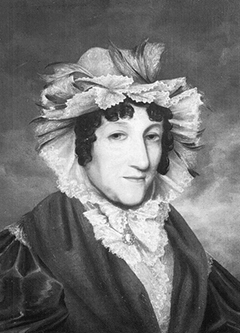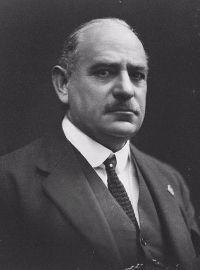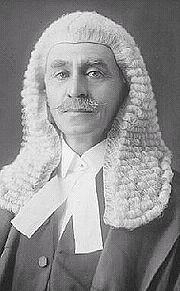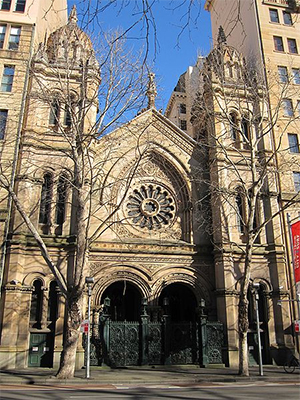Compared with other Diaspora Jewish communities, Australian Jewry is a very young community. Within two centuries, however, it has emerged as one of the most vibrant in the world. The position of Jews in Australian society has been rather different from that of Jews in other places. As historian W. D. Rubinstein has written, one of the most outstanding features has been “the normalcy of Jewish life”.

This ‘normalcy’ can be traced as far back as 1788. It has been noted that there were at least eight, and perhaps as many as 14, Jewish petty criminals among the convict cargo on the First Fleet. Thus Jews were among the first whites to arrive in Australia and so have “never been considered to be aliens to quite the same extent as elsewhere”. Most of Australia’s Jews prior to the end of the 19th century were either English-speaking convicts or migrants from Britain or their Australian-born descendants. This must certainly have added to the normalcy of their situation for, apart from religion, they passed in colonial society indistinguishable from the general population. Overall, the experience of Jewish Australians has been inextricably bound up with that of all other Australians.
By 1820 a few hundred Jewish people, mostly men, were living in New South Wales. The first purpose-built synagogue in Australia was opened in York St, Sydney, in 1844. Most of the early settlers were Anglo-Jewish, middle-class immigrants who transposed the English pattern of Jewish practice to Australia. Synagogues were modelled on the Anglican Church, with great stress on decorum and formality, and rabbis wore a ‘dog collar’ so that they looked like Protestant ministers. In 1878 the Great Synagogue in Sydney was consecrated; its imposing structure remains an historic feature of the Sydney landscape.
In the 1840s, Jewish congregations were established in Hobart, Launceston, Melbourne and Adelaide. Victorian Jewry expanded rapidly as a result of the gold rushes and increased from 200 in 1848 to 3000 people in 1861. By now Jews were, on the whole, well accepted into colonial society. In the 1860s a visiting rabbi from Jerusalem, Rabbi Jacob Levi Saphir, summed up this situation in his travelogue:
“There is no discrimination made between nation and nation. The Jews live in safety, and take their share in all the good things of the country. They also occupy Government positions and administrative posts. In this land, they have learnt that the Jews also possess good qualities, and hatred towards them has entirely disappeared here.”
When Queensland became a separate colony, a number of Jewish families left Sydney for Brisbane, where a synagogue was consecrated in 1886. The first Jewish community in Western Australia was formed in 1887 in Fremantle, then a synagogue was opened in Perth in 1897.
Assimilation into the mainstream
By the end of the 19th century Jews participated in every facet of civic, economic, and social life in Australia. When small numbers of Jewish refugees fleeing pogroms in Russia and Poland began to arrive, the Anglo-Jewish establishment was very concerned. These new Jews spoke Yiddish, were distinctively dressed and were less attuned to British or western European customs. The Establishment feared that the new immigrants would provide the wider Australian community with a new (and negative) image of what Jews were like and consequently pushed for their rapid assimilation. There were many success stories among this new group, including that of immigrant businessman Sidney Myer, founder of what is now Coles-Myer.

As the 19th century moved into the 20th, Jewish society overall became even more assimilated into the majority Australian culture, with many Jews totally abandoning their cultural heritage and identity. Jews entered mainstream Australian public life in ever-increasing numbers. So much so, that in 1917 the New South Wales Legislative Assembly had to close on Yom Kippur because both the Speaker and the Deputy Speaker were Jewish – this at a time when Jews in New South Wales made up only 0.4 per cent of the population.
Australian Jewish men and women served in the Australian Armed Forces in wars from the Sudan Campaign of 1885 through to the Vietnam War. For World War 1, 11 per cent of the Jewish community enlisted voluntarily, engaging in both front line and home front action. An estimated 15 per cent lost their lives, a figure higher than that of the general population. Australia’s greatest World War 1 leader was the Jewish Lieutenant General Sir John Monash.
More Polish Jews, also fleeing pogroms, arrived in Australia in the 1920s. There was considerable intermarriage (marriage between Jews and non-Jews) during this period and into the early 1930s. Observers of the period, both Jewish and non-Jewish, remarked on the high proportion of Jews active in public life. In an article entitled One Hundred Years of Judaism in the “Sunday Times” newspaper of 24 December 1922, for example, it was stated:

‘Every country has the sort of Jews it deserves.’ Berthold Auerbach made this epigram about his own race and if there is any truth in it, New South Wales has deserved exceedingly well. In every branch of our activities since the earliest times, members of the Jewish community have taken a large and distinguished part.
In 1933 the number of Jews in New South Wales was 10,309, but the percentage of Jews in the population had declined to 0.36 per cent. Nevertheless, the Jews’ contribution to the general community continued to outweigh their numbers. Participation in the public life of the nation was encouraged by both lay and religious leaders, as they believed that in this way Jews could prove themselves to be loyal and worthy citizens and thereby prevent antisemitism, which they now saw sweeping through Europe. As the editor of the “Hebrew Standard of Australasia” stated, the Jews of Australia were “in a land of freedom, only to remember that we are citizens of that land and it is our duty to make that land the best on God’s earth”.
Immigration and Growth of the Community
Before 1933 the Australian Jewish community was actually decreasing in size, due to a high rate of intermarriage with the local population and assimilation. After 1933 this situation changed completely. And since 1938 the Australian Jewish community has quadrupled in size, largely due to four main phases of immigration.
Before the war Australia absorbed 7,000-8,000 refugees from Nazism, many from Austria. Of these, more than 5,000 arrived in 1939 itself, so that they became known as ‘the thirty-niners’. In 1940, a further 2,000 were deported to Australia by the British government as enemy aliens on the infamous ship, the Dunera.
The largest number of immigrants arrived in the period after World War II, in the years between 1946 and 1961, the vast majority being Holocaust survivors. Between 1946 and 1954 more than 17,000 Jews arrived from Europe and Shanghai. A further 10,000 had arrived by 1961, with a significant number coming after the Hungarian uprising of 1956. A small number of Egyptian Jews also arrived in that period as refugees from the persecution which followed the overthrow of the Egyptian monarchy and the subsequent Suez Crisis. Thus, between 1938 and 1961 Australian Jewry almost trebled in size from a tiny group of 23,000 in 1933 to 60,000 in 1961.
The next phase, 1961-1981, was a period of consolidation, attracting a smaller number of immigrants, with most coming from South Africa and the USSR. Since 1981 immigration has again increased, with most immigrants still coming from South Africa and the former USSR and a smaller number from Israel.
Contributions of Australian Jews
The Jewish people of Australia have an outstanding record in law, medicine, the arts, business and government. Australia is one of the few countries in the Diaspora to have had a Jewish commander-in-chief, Sir John Monash, as mentioned earlier. Two Australian born Governors-General since 1930 have been Jewish – Sir Isaac Isaacs and Sir Zelman Cowen, both of whom are widely recognised as outstanding legal minds (Sir Isaac Isaacs was Chief Justice of the High Court prior to his appointment as Governor-General) . In the State of New South Wales, Gordon Samuels was Governor from 1996 to 2001, and Jim Spigelman served as Chief Justice from 1998 to 2011. Spigelman, the son of Holocaust survivors (and cousin of Art Spigelman, well-known for his book Maus,) has been at the forefront of major human rights campaigns, and speaks openly about his Jewish heritage.
The arts have also benefited from Jewish input at every level. Jews have made their contributions as performers and artists, as sponsors and financial donors and as audiences.
Communal Representative Organisations
World War 2 posed a number of very specific challenges for Australia’s Jewish community. In order to meet these challenges more effectively, the established communal bodies needed to broaden their base of representation and become more answerable to the full range of Jewish communal activities, not just to the synagogues.
The creation of the New South Wales Jewish Board of Deputies marked a significant break with the previous structure of the community. It provided an organisation which could act as the official spokesperson for Jewish interests and as a forum for discussion. The Victorian Jewish Advisory Board also underwent a revolution and was restructured in 1938 and changed its name to the Board of Deputies in 1948. Boards of Deputies were also created in Western Australia, South Australia and Queensland so that Australian Jewry had a fully representative structure by the early 1950s.
In the same period the various states were united for the first time in the Executive Council of Australian Jewry (ECAJ), which was created at a conference held in 1944. The ECAJ became the lay body representing every section of the Jewish community. It became the sole organization authorised to make representations to the government and the official spokesperson for Australian Jewry on all matters of lay concern such as immigration, anti-defamation, public relations and Jewish education.
International Representation
Australian Jewry has been very active in all issues relating to World Jewry. There is a strong concern for Jews in other parts of the Diaspora and communal leaders have also sought to represent Israel as effectively as possible and to lobby the Australian Government on its behalf. This work has largely been the domain of the Boards of Deputies and the ECAJ, but other bodies have also participated, particularly the Zionist Federation of Australia and B’nai B’rith.
Over the years Australian Jewry has effectively campaigned for distressed Jews in all parts of the world, including the campaign to give Soviet Jews the right to either practise their religion freely in their home country or to emigrate. Despite its comparatively small size, Australian Jewry played a significant role in this campaign and was able to enlist the assistance of some key Australian political figures, such as prime ministers Robert Hawke of the ALP and Malcolm Fraser of the Liberal Party.
The community has also been very active over the years on behalf of Jews living in Arab lands and in forging links with Jewish communities in the Asia-Pacific region. Various Australian Jews, most notably Isi Liebler, have also assumed leadership roles on the world stage, in organisations such as the World Jewish Congress (WJC), World Zionist Organization (WZO), International B’nai B’rith and the World Union of Jewish Students (WUJS).
Cultural, Social and Philanthropic Institutions
Australian Jewry has a number of important social and cultural institutions. These include B’nai B’rith, the National Council of Jewish Women (NCJW) and Kadimah in Melbourne which sponsors Yiddish culture.
Jewish cultural life as a whole has benefited from the growth of multiculturalism in Australia, particularly during the 1970s. Under the Labor government of Gough Whitlam, the Minister for Immigration, Al Grassby, recommended the establishment of ethnic broadcasting stations. The scheme was finally implemented in 1975, and since then the Jewish community has been served by Radio 2EA in Sydney and Radio 3EA in Melbourne, which in total broadcast in more than 50 community languages. The Jewish community languages are Hebrew, Yiddish and English.
Another interesting new development is the emerging role of the Shalom institute in Sydney. Shalom College, as it began in 1973, was originally a Jewish residential college at the University of New South Wales. Today, with its new name, the Institute is the centre of Jewish adult education, communal and leadership development and student and young adult activities.
In the 1980s and 1990s, Holocaust museums in both Melbourne and Sydney were established as part of increasing awareness of the Shoah (Holocaust). The 1992 opening of the Sydney Jewish Museum, dedicated to the Holocaust and Australian Jewish history and located in the historic Maccabean Hall, was heralded as “a landmark event”.
The “Australia-Israel Review” has continued to be an important publication since its establishment in the 1970s. The longest-running Jewish community newspaper is the “Australian Jewish News”, which celebrated its centenary in November 1995.
Zionist Institutions
Australian Jewry is extremely supportive of Israel. The community maintains a plethora of Zionist organisations which focus on fundraising, Zionist education including a range of Israel experience programs, youth movements, promotion of aliyah and a range of cultural institutions. Israel has recognised this by continuing to provide strong funding and other support for the Australian Zionist Movement, which also enjoys representation at the most senior level of the Jewish Agency.
Current Jewish population and identity
Geographically, 90 per cent of the Jewish community is concentrated in Melbourne and Sydney with a population of 45,000 to 50,000 and 45,000 Jewish people respectively. In both Melbourne and Sydney there are two areas of geographical concentration. In Melbourne, Jews are largely concentrated in the south-eastern area, including Caulfield, East St Kilda, Toorak; and the north-eastern suburb of Doncaster, which has attracted many of the South African immigrants. In Sydney, 63% of all Jews live in the eastern suburbs, many in Bondi; while the second area of Jewish concentration (22%) is in the north around the suburb of St Ives, again a very popular area for the South African immigrants.
There are also Jews in Perth (the third largest Jewish community), Canberra, Brisbane, the Gold Coast, Adelaide, Hobart and Launceston. There are congregations in country areas and smaller cities such as Newcastle and Wollongong in New South Wales.
This geographical concentration is very important in understanding the issue of Jewish identity. In order to lead a Jewish life, it is necessary to be close to Jewish facilities such as schools, synagogues and kosher food outlets.
The following are some population figures detailing the growth of Australian Jewry:
1788 – 8
1933 – 23,000
1954 – 48,000
1961 – 60,000
2001 – 100,000
2011 – 97,000
2016 – 91,000
The History of New South Wales Jewry
Jews have lived in the free and open society of NSW for the duration of European settlement. While a significant number of Jewish convicts arrived after 1788, organised Jewish life did not start until 1817 with the formation of a Jewish Burial Society in Sydney.
After 1828 free English Jewish settlers began to arrive and the first regular services were held in the home of P.J. Cohen. After renting premises, the congregation moved to the first purpose-built synagogue in York Street, Sydney, in 1844. In 1878 the Great Synagogue, Sydney, was consecrated with Rev. A.B. Davis as its first minister. Its imposing structure remains an historic feature of the Sydney landscape, the building being substantially restored for the bicentennial in 1988.


The interior and exterior of The Great Synagogue, Sydney.
During the 19th century a high proportion of Jews in NSW lived in country areas, with communities in Goulburn, Maitland and Grafton, and later in Newcastle and Broken Hill. These communities were too isolated and today the only reminder of their existence are the Jewish gravestones in country cemeteries and disused synagogues, apart from the Newcastle Synagogue which continues to function.
In this period Jews participated in every facet of civic, economic and social life of NSW and prominent figures included Sir Saul Samuels, Sir Julian Salamons and later, Sir Daniel Levy and Justice Henry Emanuel Cohen. Sydney Jewry contributed to the war effort during both the First and Second World Wars and NAJEX, the Jewish Ex-Servicemen’s organisation, was formed to support those involved in fighting for their country.
While the Sydney Jewish community was enriched by small numbers of Jewish refugees fleeing the Russian pogroms at the turn of the century, and by Polish Jews arriving in the 1920s, these ‘foreign Jews’ did not have a significant impact on the community.
It was the Jewish refugees who arrived largely from Central Europe in 1938-1939, escaping from Nazism, who laid the basis for the dramatic changes and evolution of Sydney Jewry. These changes included the formation of the NSW Jewish Board of Deputies in 1945, the Australian Jewish Welfare Society (now the Jewish Community Services), the Temple Emanuel and Moriah College. With the further influx of Holocaust survivors after the war, the community grew, with a large number of suburban synagogues being established.
Further waves of immigrants from Hungary in the mid-1950s, South Africa, Russia and Israel in 1970s and 1980s have enriched our community which today has more than 20 Orthodox Synagogues, two Temples and, five Jewish day schools (Masada, Moriah, Mount Sinai, Emanuel and Yeshiva). The schools cater for about 50 per cent of Jewish children in Sydney.
The many organisations in the community include the NSW Board of Jewish Education, the Montefiore Home, the Jewish Communal Appeal (JCA), a strong Zionist structure with United Israel Appeal(UIA), Jewish National Fund (JNF), Women’s International Zionist Organisation (WIZO), the State Zionist Council and the National Council of Jewish Women, the first women’s organisation formed in NSW, which combines support for Israeli, local Jewish and general causes.
Cultural life has also developed with B’nai B’rith, a service organisation, the Folk Centre for Yiddish culture, the Jewish Arts and Culture Council (JACC) and the Hakoah Club with a membership of more than 10,000. The opening in 1992 of the Sydney Jewish Museum, dedicated to the Holocaust and Australian Jewish history and located in the historic Maccabean Hall, was a landmark event for this community.
The Jewish community in Sydney currently numbers about 40,000 people. Jews can be found in all parts of the Greater Sydney area, although approximately two-thirds reside in the Eastern Suburbs, from Vaucluse, through Randwick, Bondi and Double Bay, to Darlinghurst (East Sydney), where the Jewish Community Centre, the Sydney Jewish Museum and the B’nai B’rith Centre are located. Most of the remainder live on the north side of the Harbour, predominantly in the suburbs situated between Chatswood and St Ives.
Individual Jews and the community as a whole have contributed significantly to the larger community, with leaders such as George Judah Cohen, Sydney D Einfeld, Professor Julius Stone and Professor Peter Baume coming from its ranks. In this way, NSW Jewry has contributed to and benefited from the wider community, enriching the multiculturalism of present-day Australia.
Adapted with permission from
Edge of the Diaspora by Suzanne Rutland, Brandl & Schlesinger, 1997
Further Reading
Jewish Virtual Library: Australia Virtual Jeiwh History Tour
ABC News: While some Jewish Australians are on the rich list, nearly one in five live in poverty


